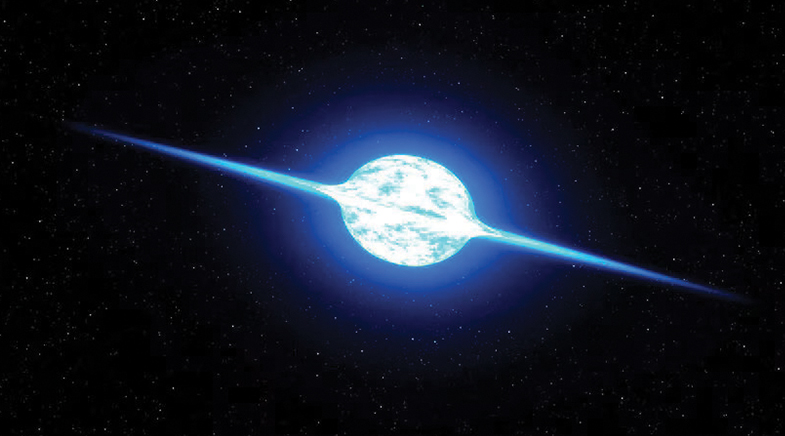Be team plays a stellar role
-
- from Shaastra :: vol 04 issue 08 :: Sep 2025

Scientists offer fresh insight into how massive stars form and evolve.
In the days when power cuts were a regular occurrence, Annapurni Subramaniam, as a schoolgirl, spent her evenings looking at the night sky from the courtyard of her house in Palakkad, Kerala. Subramaniam — now the Director of the Indian Institute of Astrophysics (IIA) – especially enjoyed stargazing on summer evenings. As the stars glittered in the dark canopy of the sky, she noticed that the night sky changed with the seasons. It sparked her interest in stars, and she pored over books in public libraries and collected night sky maps from The Hindu newspaper to identify constellations.
Old habits die hard. As it happened, Subramaniam was observing the sky with the Himalayan Chandra Telescope (HCT) in Hanle, Ladakh, some 20 years ago, when she spotted a rare type of star surrounded by a gaseous disc, which was quite unlike the Sun. The telescope was a little out of focus, but the skies were exceptionally clear. She decided to continue observing the sky, using spectroscopy, which allows scientists to identify the elements in a star by studying the distinct colours they produce in its spectrum.
The rare star, she realised, was a Be star, belonging to a special class of hot, rapidly rotating stars called 'B'-type stars. "Detecting a Be star was an accident," Subramaniam recalls.

These stars are the only kind known to have a rotating gaseous disc around them. Their fast spin causes them to eject matter that forms a hot disc around the star. Spectral analysis of these stars reveals emission lines instead of the usual absorption lines, leading to their categorisation as classical Be stars. In Sun-like stars, photons originate in the hot core and pass through cooler outer layers, where some wavelengths are absorbed, producing an absorption spectrum. Be stars, in contrast, have a hot gaseous disc that excites photons and causes radiation, producing an emission spectrum.
Subramaniam and her group have now found that 'companion stars' play a major role in creating Be stars. Their study of a young star cluster called NGC 663, reported in the journal Astronomy & Astrophysics in May 2025 (bit.ly/Be-uvt), offers fresh insight into how massive stars form and evolve.
Stellar systems are the building blocks of the universe and synthesise all elements except for hydrogen and helium, and small amounts of beryllium and boron. The way stars process materials influences planetary formations and the possibility of life. "(While) understanding the origin of different elements, scientists need to know which types of stars produce them. For example, neutron star mergers are known to produce heavy elements like gold and nickel, as seen in the asteroid Psyche," Subramaniam says. Since the Earth and the Sun cannot produce certain metals, it is necessary to determine which stars and processes create them. Be stars, she adds, are an important link in this chain.
Studying Be stars helps researchers probe what causes their rapid spin and disc formation — past mass transfers or tidal effects. Former IIA director Kalyan Kumar Ghosh had probed Be stars in the 1970s. Subramaniam revived this line of research in India, working with her former student Blesson Mathew, now an astrophysicist at CHRIST (Deemed to be University), Bengaluru.
Often, Be stars are accompanied by other compact objects such as neutron stars, white dwarfs and black holes. A Be star paired with a compact object forms an X-ray binary, which emits high-energy photons (light particles). These X-ray binaries act as a fossil record of massive star evolution, revealing how close the binary object is when one star loses mass, explodes, or collapses.
DANCING PARTNERS
Subramaniam's team used ultraviolet (UV) images from India's AstroSat space telescope to examine NGC 663 in detail. Out of the 23 known Be stars in the cluster, 19 gave off more UV light than expected, suggesting they had hot companion stars. The companions, they found, were subdwarf stars, which are even smaller than white dwarfs.
The team discovered high-mass, hot subdwarf companions in such systems. Almost 70% of the Be stars in the cluster were part of binary systems, providing evidence that companion stars play a major role in creating Be stars. Until now, classical Be stars were thought to form their discs entirely from their own mass loss. The group's findings raise a new question — does the disc material come from the Be star itself, or from its companion? Further studies may reveal an answer.
In a separate study (bit.ly/optical-infra), Mathew's research group at CHRIST focused on spectroscopic studies of Be stars. When a Be star has a compact companion such as a black hole, neutron star, or white dwarf, the system can emit high-energy X-rays, along with optical and infrared signals. Since access to X-ray telescopes is not always easy, the team investigated whether optical observations could help uncover the secrets of Be star binaries — systems usually hard to detect through optical means. They identified clear optical signatures in such binaries that could reveal the systems' mechanisms and evolution.
"We spotted optical and infrared signatures of Be star binaries that can be detected with an optical telescope, helping us reduce our dependence on X-ray telescopes," explains Suman Bhattacharyya, a member of Mathew's group and a co-author of the study.
SECRET OF THE DISC
Last year, Bhattacharyya was at the European Southern Observatory, in Germany, which houses some of the world's most powerful telescopes. For 12 months, he and his group collected and analysed data on Be stars. During his stay there, he had the opportunity to investigate an enduring puzzle: why discs form in Be stars.
The researchers used the Transiting Exoplanet Survey Satellite, a National Aeronautics and Space Administration telescope, to study about 30 mass ejections in 13 Be stars. They found (bit.ly/Disc-form) that right after an outburst, the ejected gas comes from a small region on the star's surface and orbits the star at speeds close to what's expected near its surface. Within a few orbits, the gas spreads evenly to form a disc. This happened irrespective of whether a disc was already present. They did not find any signs of a 'warning' activity before the ejections. Part of the brightness changes during the events came from the star itself, and not just the disc.
Studying long-term emission line data may help explain several types of cosmic objects that change over time.
The team also aimed to test current ideas about how Be star discs grow and fade. Earlier studies, based on short-term observations, suggested that discs form quickly and fade slowly. With a 19-year dataset, they could check whether this pattern holds or changes over time. "Our methods could be applied beyond Be stars," Bhattacharyya says. Studying long-term emission line data (spectroscopic data) could help explain several types of cosmic objects that change over time. "By combining with machine learning, (we) revisit old ideas and improve our understanding of how stars work," he adds.
BEYOND ASTROPHYSICS
"Be stars are ideal laboratories for studying stellar rotation," says Gourav Banerjee, a postdoctoral researcher at the IIA. About 15-20% of Be stars show extremely high rotational velocities, often exceeding 200-400 km/sec, vastly greater than the Sun's average rotation speed. Yet, stellar rotation remains one of the least understood parameters in astrophysics. Studying these fast-rotating stars can help researchers better assess the role of rotation in stellar evolution and disc formation.

"Classical Be star discs naturally maintain hot gaseous states at temperatures exceeding 10,000 Kelvin for several months, making them the only natural laboratories available for such research," Banerjee says. "These exotic stars are the only natural source for understanding how gas particles behave in high temperatures."
A deeper understanding of gas particle behaviour at extreme temperatures may one day revolutionise transportation technology, Banerjee believes. While humanity already benefits from innovations such as satellite communication and high-speed vehicles enabled by space science, future advancements may depend on developing gaseous fuels. However, to make this leap, scientists must first understand how to confine and control hot gas particles, a challenge that could potentially be solved through continued research on classical Be stars, he says.
While many astrophysical reasons exist for studying Be stars, perhaps the greatest long-term value lies in their potential to offer insights into energy, materials, and propulsion technologies. "There is an urgent requirement for cross-field communication in this field," Mathew says.
Have a
story idea?
Tell us.
Do you have a recent research paper or an idea for a science/technology-themed article that you'd like to tell us about?
GET IN TOUCH














